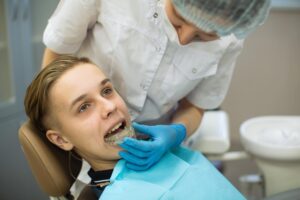We all want a beautiful, healthy smile but achieving that becomes a challenge because of teeth misalignment issues caused by various dental problems like teeth crowding, overbites, underbites, and numerous other factors that can result in a less than perfect smile. One of the best and most effective ways to achieve your desired smile is to wear braces. While there are newer treatment options, braces remain the most popular choice for adults and children with various dental problems.
But, how do braces work? Braces help correct your smile by applying pressure on your teeth, slowly encouraging them to shift into the correct position in a healthy and natural way. There are four different types of braces to choose from depending on your dental issue. These include metal, lingual, ceramic, and clear aligners, like Invisalign. Your braces may also include wires, bands, and other corrective appliances based on your specific needs.
In this article, we will look at common dental problems that you can correct by wearing braces:
Common Problems Braces Can Correct
1. Overcrowding
Crowding is a common dental problem experienced by many people. It usually occurs when your mouth doesn’t have sufficient space for your teeth to grow properly aligned. Dental overcrowding causes your teeth to appear misaligned and twisted. Over time, overcrowding can make it difficult to brush and floss your teeth, increasing the chance of plaque buildup and bacterial growth. This, in turn, results in gum disease, cavities, aching jaw, and problems with your overall health. Besides, having crowded teeth can negatively impact your confidence and self-esteem in social situations.
However, braces offer one of the most effective and safest ways to treat teeth overcrowding. If you have severe teeth overcrowding, an orthodontist like Dr. Bob Bryan in Allentown, PA can remove one or more teeth and then apply braces to move the rest of your teeth into the correct positions. The treatment period usually depends on the severity of your condition. If you have severe overcrowding, it might take longer to get your teeth corrected than when it’s mild to moderate.
2. Spacing
Spacing, also known as diastema, is another common orthodontic problem that you can correct using braces. Visible gaps between your teeth usually characterize this dental problem. It’s often common in children but can carry on to your adulthood. While teeth spacing is rarely a cause for alarm, it can cause other dental problems like increased cavities and gum disease if not treated. This is because the gaps promote the buildup of food particles and plaque if you don’t practice proper oral hygiene.
On top of that, if your teeth’ spacing makes chewing difficult for you or causes any discomfort, it’s best to seek corrective treatment using braces. Braces are an effective treatment option for both children and adults with tooth spacing problems. Braces can help fix your teeth spacing problem by adjusting the spaced teeth position to close the gaps.
3. Misaligned Jaw
If you experience pain on your face, have difficulties chewing, talking, and breathing, or your teeth wear unevenly, your jaw might be misaligned. Major causes of jaw alignment issues include underbite and overbites, overcrowding, or misaligned teeth. But can braces fix your asymmetrical jaw?
The answer is yes. Braces can help correct your misaligned jaw by correcting teeth misalignment to allow your jaw to sit in its rightful position. The treatment can take anywhere between 6 and 18 months to get the desired outcome. It can also take longer, depending on the severity of your condition. And apart from reducing facial pain and allowing better chewing, fixing a misaligned jaw could also help improve your facial appearance.
4. Braces Can Correct Overbites and Underbites
Uneven bites are common dental problems that you can fix using braces. Overbite happens when your top front teeth protrude outwards than usual, leaving a gap between the upper and lower teeth. This makes chewing and biting difficult for you. Braces can fix your overbite problem by shifting your upper teeth backward to align them with the lower teeth.
On the other hand, an underbite happens when your lower jaw extends past your upper jaw. It can result from having a too big lower jaw or a smaller than usual upper jaw, causing an unbalanced facial appearance. Underbites can cause more severe problems like jaw conditions, pain, or teeth damage if left untreated. Braces can correct your underbite problem by exerting pressure on either your upper or lower teeth, moving them in their required position. If your underbite problem is severe, your orthodontic may recommend jaw surgery combined with braces to ensure proper alignment.
5. Open Bites
An open bite happens when your upper and lower teeth don’t come together or leave a gap between them, even with your mouth closed. An open bite can develop either on the back or front of your mouth. This rare malocclusion issue is common in small children who excessively suck their fingers or often use pacifiers. However, your child may outgrow it after their permanent teeth fully develop.
But if your open bite was caused by some other factors like jaw injuries or genetics, consider corrective treatment with braces. Braces work by moving the misaligned teeth to their rightful position, correcting your open bite problem, and making your bite balanced. When not treated, your open bite condition may cause other issues such as gum disease, uneven teeth wear, jaw issues, and problems with speech, chewing, and biting.
6. Asymmetrical Dental Midlines
Dental midlines misalignment occurs when the middle of your two upper and bottom teeth appears off-center. Common causes of your dental midline discrepancy include teeth crowding, missing teeth, jaw misalignments, and oversized or undersized teeth. Other causes include excessive thumb sucking, uneven chewing, or jaw injury.
Severe midline issues can lead to jaw pain, tooth decay, gum disease, and even affect your facial appearance. Braces assist in correcting midline misalignment by adjusting the position of your teeth to ensure they’re correctly aligned.
Braces are an ideal treatment to correct common dental issues.
Braces are ideal treatment options for children and adults with various dental problems, whether jaw misalignments, overcrowded teeth, or asymmetrical dental midlines. By properly aligning your teeth using braces, you also enhance your chewing and speech. Also, since braces help you achieve the perfect smile, they indirectly help boost your confidence, improving your emotional, spiritual, and physical well-being.
Despite the many benefits, there are also disadvantages of braces, including gum disease and tooth decay due to poor hygiene, discomfort from wires digging into the gum, and can increase your risk for injury, especially if you play sports. One of the main problems with braces in adults is that they take longer to achieve the desired results than children. As an adult, your bones have stopped growing and aren’t that pliable, taking more time to adjust your teeth and achieve the desired results.
So, if you have any of the above-mentioned dental problems, you may want to consider wearing braces to correct the issue.
If you would like to correct your dental problem with braces, contact your orthodontist in Allentown today. And we’ll help determine the best types of braces to wear so that you can get your smile back in the shortest time possible.







